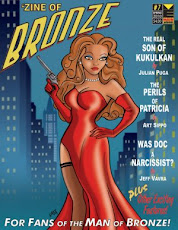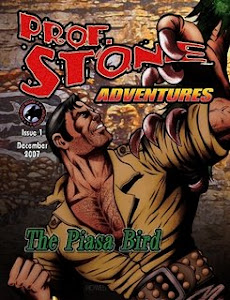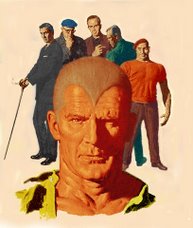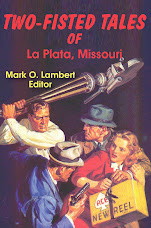In the Super Sagas, Doc and his men use bulletproof undergarments that are composed of light metallic chain-mail. These can garments can range in size from a torso protecting vest to long-johns with arm length sleeves. They usually are depicted as protecting the chest and abdomen. Even when they stop a bullet, the kinetic energy is still depicted as causing bruising or even cracking ribs underneath. The degree of protection provided by these undergarments varies in different stories and seemed to increase over time. In the post WWII story The Ten Ton Snakes, the vest is described as capable of protecting a man from a 30-06 military rifle shell at point blank range. In this article, we will discuss what a bullet proof vest is and what technologies Doc Savage had to provide in order for the protective undergarments to function as described in the story.
Ordinary bullets damage the body in two ways. First there is penetrating trauma where the bullet enters the body and directly damages internal structure. This is the most devastating effect of the bullet and the one most like to induce a fatality. Such internal trauma can in fact cause virtually instant death. The second type of injury is from kinetic trauma which can be transmitted to tissues which have not been directly in contact with the bullet. Modern high-velocity military rounds that enter the body at speeds in excess of 2000 feet per second can induce shock waves in soft tissue that disrupt cells and blood vessels and devitalize tissue for several centimeters around the bullet's path in tissue. In cases where body armor is worn, the impact of the bullet can still induce serious injury to bones and soft tissue that can be life threatening even though the bullet does not penetrate the skin.
So the goal of any body armor is to not only prevent penetration but also to attenuate the kinetic energy of the bullet to prevent its transmission to the body.
A plain chain-mail vest will likely prevent penetration but it will do little or nothing to attenuate the kinetic energy of the impact. It would therefore be necessary to have some type of padding or some rigid plates to distribute the force of the impact over a larger area. In the early 1930s, the usual weapon of the criminal classes was a .32 caliber or .38 caliber pistol. Such rounds were effective at close range but they did not have much knock down power. A simple chain mail vest with a padded backing would have been enough to prevent penetration and attenuate the force of the impact. But when you got up to the .38 special and the .45, the chain mail would have been hard pressed to stop penetration point blank and the force involved would cause contusion injury through any conceivable simple padding.
Modern bullet proof vests use woven plastic polymers such as Kevlar over a backing that will sometimes contain hardened metal or ceramic plates. Metal plates may deform under impact and undergo metal fatigue. Ceramic plates shatter and absorb kinetic energy by doing so. In both cases, the vest is permanently altered and may provide the same protection after more than one or two bullet impacts. The problem with the polymers is that such vests will fail if they get wet since water helps to lubricate the bullet through the weave and can chemically disrupt the polymer molecules themselves. And they are only really effective against pistols up to the .357 Magnum and the .45. Larger pistol shells like the .44 Magnum or the .454 Casull and rifle bullets like the 30-06 will both penetrate such vests and deliver significant kinetic damage. There are more sophisticated armors now that use kinetic-reactive plastics and even spider-web material which change their tensile strength and rigidity under stress. In some materials, the introduction of a rapid kinetic jolt alters the viscoelasticity of the material so that the entire vest goes rigid attenuating the force of the impact over a very large surface area.
The undergarments Doc's men wore were supposed to be light weight but containing metal mail. A good closely woven metal mail would provide excellent penetration protection and would minimize metal fatigue in the impact areas. If the alloy were properly formulated it would also become harder under rapid stress. (There are several alloys known today that will do this.) This would solve the penetration problem. But this would also require a padded backing material to attenuate the kinetic impact. I propose that the metal mail was worn over a cloth under garment with an internal cotton lining and an external plastic polymer weave that became rigid over a large area upon sudden impact. Such a polymer may have been sealed against water to prevent degradation of performance in harsh conditions. The use of the metal mail would also guarantee protection while wet. Theoretically such a vest could give the performance described in the Super Sagas even against 30-06 ammunition.
The technology that Doc Savage had at his disposal was always anywhere from 30 to 60 years ahead of its time. We are only now contemplating making a protective garment with the above performance characteristics but we are still using polymer weaves to prevent penetration. Maybe Doc knew better and an external covering of woven metal-alloy mail with varied tensile strength under stress is the way to go.
Saturday, July 7, 2007
Subscribe to:
Post Comments (Atom)


























2 comments:
Chainmail sufficient to protect against a point blank bullet would have to be very thick and be too heavy to wear.
In the 30's criminals also had access to 45 caliber. The 'modern' high velocity rifle round was invented in the late 1890's. The 8mm mauser rifle round can penetrate a 1/4 inch of carbon steel with regular lead bullets, and it was in use in 1898. Armor piercing bullets will penetrate 1/2 inch steel. The 45 caliber 1911 was invented not long after and was used by many criminals in the 1930's. Remember the tommy gun? 45 caliber machine gun. Simple killing technology that no chain mail you could wear and still be able to walk would stop.
The problem with chain mail is the chain breaks when even small bullets are used. This is why no one uses chain mail anymore. This is why chain mail went out of favor when guns were invented.
1930's handguns are really little changed from todays handguns. A few refinements, yes, but for the most part, every bit as deadly as the majority of todays handguns.
Doc Savage stories were great, but sometimes authors get it wrong, or just make it up for the sake of the story. It doesn't make the fiction any less enjoyable though.
Hi Mike!
The .45 caliber automatic was a powerful hand gun designed n the early 20th Century for its knock down power. It was adopted by the US Army as standard issue during the Philippine Insurrection when berserker terrorist would drug themselves and then charge American positions. They were so highly drugged that the close combat weapon - the .38 - wouldn't even slow them down. The .45 slug on the other hand had superior knock down power that even the drugs could not combat.
But a .45 was a large ungainly weapon that was prone to jamming and was very hard to conceal. A .32 pistol could fit in your pocket with little trouble. Some models had no external hammer so that could slide in and out of pocket smoothly without the hammer getting caught. And both the .32 and .38 were easy to fire in close quarters. A .45 packs quite a wallop and is harder to control. I am sure that SOME criminals used the larger weapon and it was actually easier to get a Tommy Gun than a pistol in the 1920s. But even today, the "Saturday Night Special" that is the favorite of most criminals is still a small caliber gun that is easy to conceal. In fact professional killers actually prefer the .22 because of its size and its relatively quiet report.
I still think that the usual caliber Doc and his men would have run into was the .32 and the .38 bullets.
Indeed the technology in 1933 technology would have been hard pressed to stop such a bullet using a light weight chain-mail with then known materials.
Lester Dent went even further and in the 1940s alleged that the bullet proof underwear that Doc Savage and his men used could stop a 30-06 combat rifle round point blank. Not bloody likely.
One thing we must remember is that the Pulp action stories were "gee-whiz" fantasies that often tried to hawk technology as both a solution to many of life's ills and a potential danger as well. These authors pushed the envelope of what was possible and sometimes went way beyond that.
Could a lightweight chain-mail ever be made that a .45 pistol bullet or even a combat rifle round could not penetrate? One thing I have learned is that you "never say never" to such questions.
The first bullet proof vests were invented by a Catholic Priest in Chicago, Illinois and was made from sheets of silk. In fact Archduke Ferdinand was wearing one of them when he was killed by the Serbian terrorist's bomb.
Doc Savage had access to "advance materials" far beyond the knowledge of his contemporaries. What he would have needed was a kind of hard yet resilient alloy that could deform without breaking and maybe had a built in 'memory' so that it would rebound to its normal shape. Then there would need to be a kinetic dampener as I mentioned on the blog to help absorb the kinetic energy and momentum of the impact. In fact some kind of "memory metal" would be preferable to modern ceramic and polymer vests which irreversibly destroyed by the force of the bullet so that they must be discarded after one use.
This would indeed be an exotic kind of bullet proof vest which (if it could do what Dent claimed that it could) would be way beyond even modern early 21st Century technology. But it might not be so for very long.
Art Sippo
Post a Comment